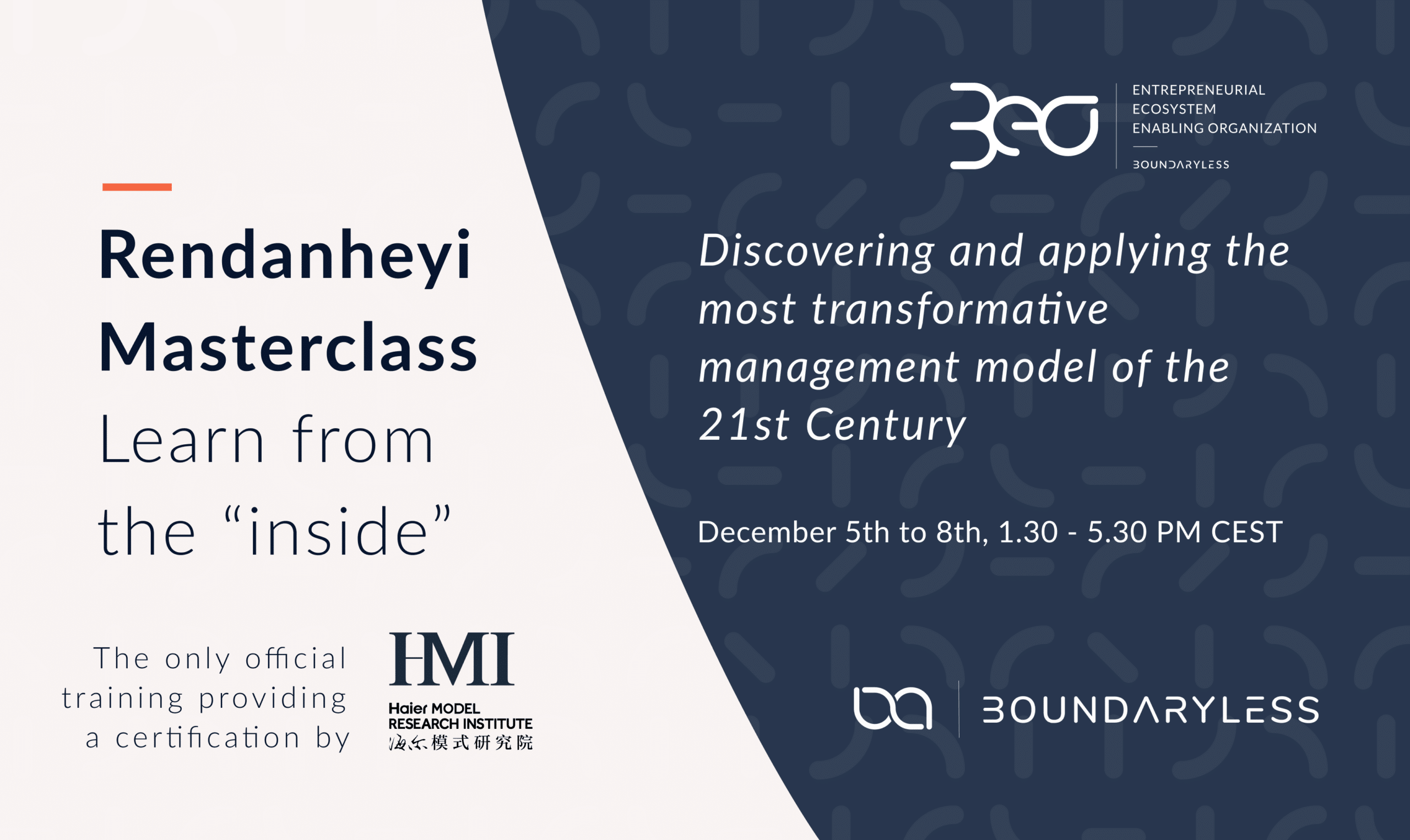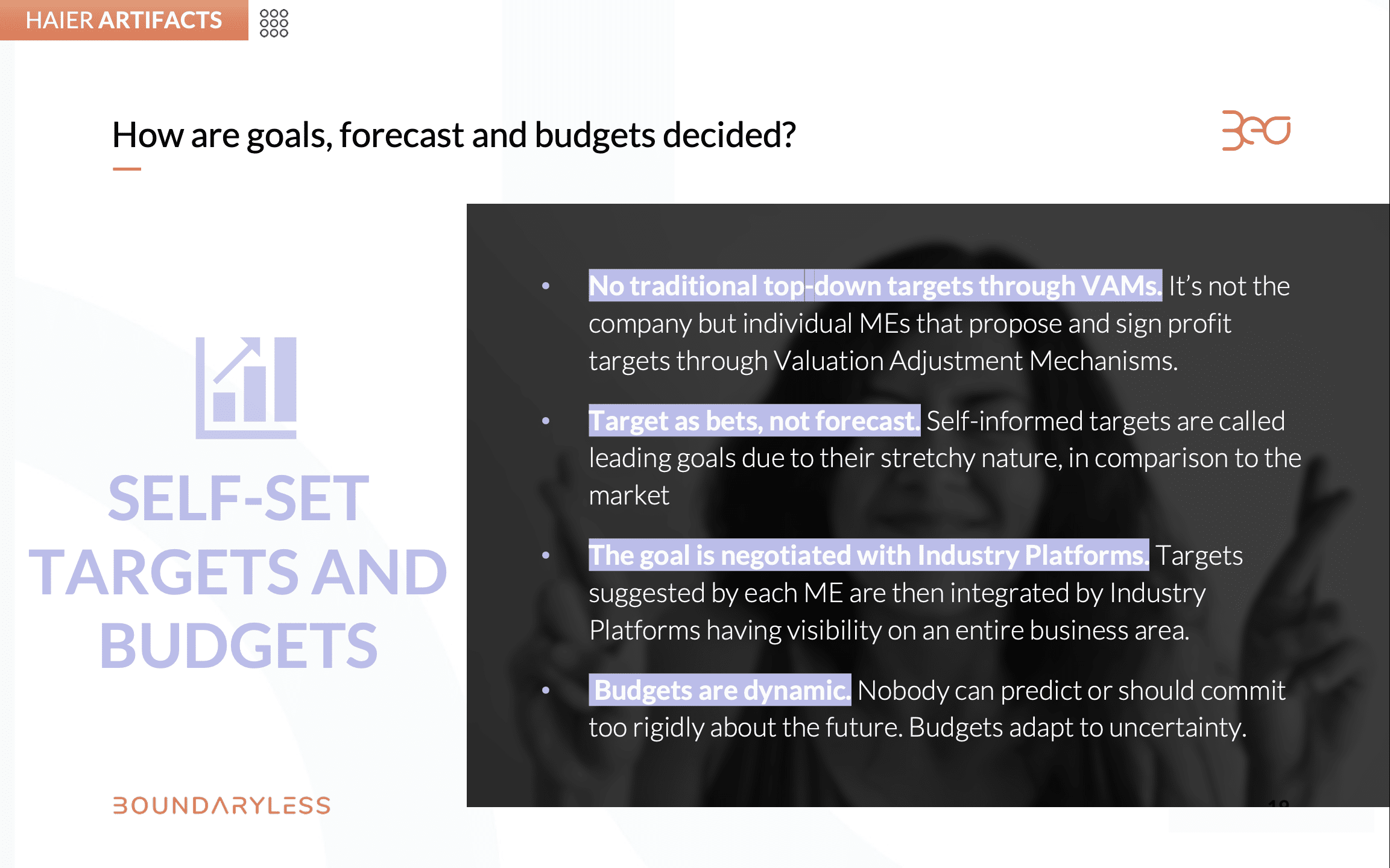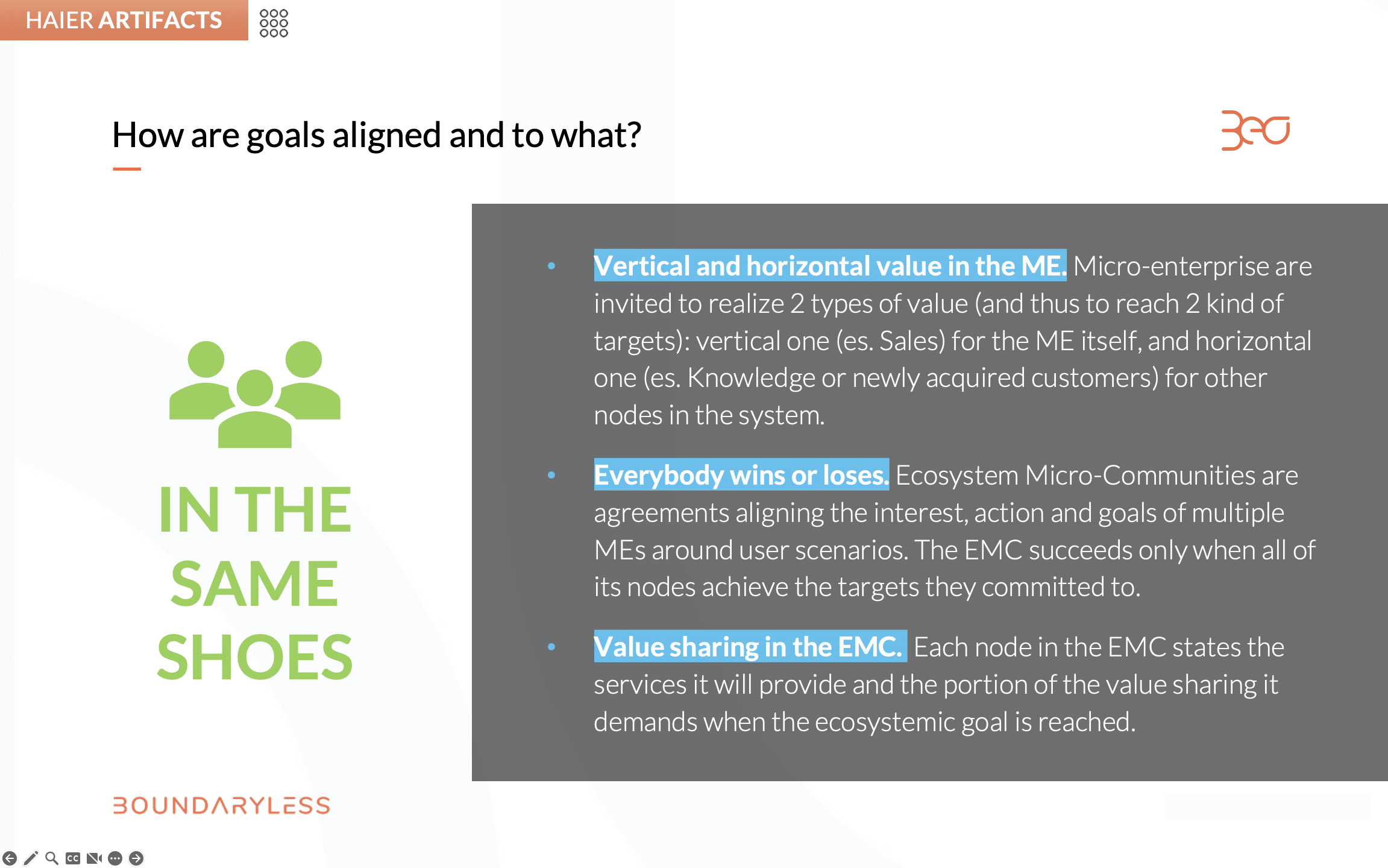Power, Pay, Purpose with No Managers
How Haier’s RenDanHeYi and our 3EO practices go beyond the roadblocks of current Human Resources and Organizational structures to define compensation and reward systems that motivate human beings, unlock colleagues’ ability to feel realized, generate impact, and reduce organizational debt.

Emanuele Quintarelli
Abstract
At the end of September, SociocracyforAll, a non-profit organization spearheading self-management, particularly Sociocracy, hold the first edition of its Power, Purpose, and Pay: Ways to decide about money together conference. The goal of the event was to collect and share wisdom among leaders, consultants, and practitioners from adaptive, self-managed, and decentralized organizations with specific experience in the financial and budgeting sphere. This included salaries, target setting, performance evaluations, investments, and rewarding in more horizontal (or even boss-less) contexts.
As invited speakers, the Boundaryless 3EO team picked selected insights from Haier’s RenDanHeYi and our own 3EO practices to support quite an extreme perspective regarding how far it is possible to go from the roadblocks more or less explicitly hidden in current Human Resources and Organizational structures, to define compensation and reward systems that motivate, unlock colleagues’ ability to feel realized, generate impact and, in doing so, reduce organizational debt.
In our speech, we addressed:
- How power and decision-making are represented and expressed through and across Micro-Enterprises.
- How targets are conceived, defined, and leveraged through the involvement of Industry Platforms, VAMs, and leading goals.
- How pay can be determined and come from customers, not from the firm.
- How multiple interests can be composed and aligned without adding unnecessary bureaucratic layers, processes, and structures.
Most of such solutions are extensively described in our 3EO Framework, an open-access model designed to democratize the RenDanHeYi philosophy and similar strategies. This framework enables the creation of entrepreneurial, ecosystem-centric organizations composed of a collaborative network of entrepreneurial units, thereby enhancing the organization’s agility and resilience in a dynamic environment.
For a comprehensive understanding of RenDanHeYi/3EO, consider participating in the 3EO/RenDanHeYi Masterclass, scheduled for next week from December 5th to 8th.

The Power, Purpose, and Pay Conference
At the end of September, SociocracyforAll, a non-profit organization spearheading self-management, particularly Sociocracy, hold the first edition of its Power, Purpose, and Pay: Ways to decide about money together conference. The goal of the event was to collect and share wisdom among leaders, consultants, and practitioners from adaptive, self-managed, and decentralized organizations with specific experience in the financial and budgeting sphere.

The topics and references
The agenda of the event featured rich perspectives and conversations touching upon many self-management taboos or hard-to-tackle topics. Here are a few, should you decide to go deeper:
- New pay models in which salary is the result of an opaque, often skewed, surely not value-drive conversation among a manager (or HR) and an individually evaluated employee.
- Transparent, dynamic and participatory budgeting systems in terms of the design questions, principles, and potential solutions coming from multiple self-management environments. Other learnings from participatory budgeting have also been shared.
- How salary can be self-set salaries starting from Semco’s lessons learned in terms of effectiveness and fairness
- Customer-generated budgeting from Zappos’ market-based dynamics approach
- How to emotionally and technically allocate funds and surplus value in a both transparent and democratic way
- Aligning targets and pay to both regenerative thinking and company’s specific vision, values, and intended impact on the planet
- An experiment about target setting, forecasting, and resource allocation inspired by Beyond Budgeting ideas at The Ready
- Conceiving budgeting as a flexible, adaptive, and agile process able to support innovation and experimentation
- Tools supporting governance transitions for open collectives
Most speeches have been recorded and will be available on the conference’s website. Simply reach out to us, if you are interested in our talk’s recording.
RenDanHeYi’s approach to power and rewarding
Our intervention, titled “How to self-manage pay through the RenDanHeYi“, introduced many pillars of Haier’s thinking, such as:
- The difference between employees and (internal or external) entrepreneurs.
- How to infuse real skin in the game, even in traditional organizations.
- The novelty and effectiveness of having pay flow outside-in from the customers and the market, not inside-out from the firm to employees.
- The amount of freedom left to teams to decide how to share the value they create together.
As an underpinning reflection, the presentation addressed the non-trivial trade-offs behind most pay-related organizational practices, namely how to dynamically balance organizational coherence (purpose, strategy, values), extreme power distribution (product responsibilities, decision making, people allocation, value sharing), and a more central role for the market when it comes to incentivation and the circulation of returns.
Each angle of the speech is briefly discussed below, with the supporting slide and accompanying considerations.
This post is meant for practitioners with a previous understanding and at least basic RenDanHeYi experience. If you are new to Haier’s organizational model and 3EOs, please consider going through a refresher about it is foundational concepts.
Diffused power and distributed decision-making
Compensation and the decisions about it are just one of the many incarnations of how power “happens” in organizations. Alignment between broader decision-making abilities and salaries is an aspect often undervalued in organization design. That’s why we decided to start our discussion at the conference from Micro-enterprises more than from individuals within them.
The Micro-Enterprise is, indeed, the natural container within which employees can determine both their roles and compensation. Within the RenDanHeYi:
- It is the self-managed, semi-autonomous basic unit from which a 3EO is composed. It is meant as a group of colleagues and self-contained scope (for example, a product or service) with separate responsibility for Profit and Loss. Please note how it is only by distributing freedom to Micro-Enterprises at the edge of the firm that individuals can enjoy a much broader, non-bureaucratic, customer-driven space to determine how they’ll personally benefit from the work environment.
- MEs are where profit is primarily managed but in a collective fashion. This is true because some of the value generated by the ME is left within it and can be arbitrarily allocated to its members. They can freely decide what to do with the returns, whether that is monetizing them immediately or investing in new initiatives that will increase the value of the ME in the future. All of it happens without any external approval or influence.
- The 3 rights of the Micro-Enterprise. More than a team, each ME enjoys a sort of a bounded anarchical power, acting as the sole ruler on its direction (what it does, when, how, etc.), its team (the people with their roles, competencies, and interactions), value distribution (meant as salaries, bonuses, profit-sharing and any other stipulation among employees and the ME leader).
While not formally prescribed by Haier, in our experience, all of this is fully transparent and largely participatory: both the creation of a Micro-enterprise and the attraction of individuals to it are open, iterative, group conversations through which human beings find their desired place at a specific moment in time, while the overall system learns and iterates from the multiple “business experiments” conducted concurrently by each team.
A synthesis is provided by the slide below:

Participatory target setting and budgeting
Even more than in the blank space left within Micro-enterprises, the magic appears in the negotiation between them and the firm. In other words, forecasting, planning, budgeting, and target setting are no longer centralized or cascaded down from top to bottom in the RenDanHeYi.
Instead of pretending to know the future, the firm allocates goals and resources through a complex network of bets among individual Micro-enterprises and Industry Platforms, in representation of the strategic priorities of the business:
- Valuation Adjustment Mechanisms (VAMs) are investment agreements through which the ME and the firm actively negotiate about the results to achieve, how to measure them, the funds and supporting resources required, how the ME activity will benefit the rest of the organization, how ME’s members will reap some of those results.
- The long, slow, expensive, often fictional, yearly forecasting process gets simplified into many smaller, less risky, more dynamic, and braver, customer-informed decisions involving the ME, the Industry Platform, and the market. With more granularity, incrementality, and optionality (thinking about many futures instead of trying to predict the “right one”), the process effectiveness is dramatically improved, while its cost becomes smaller. Even more importantly, teams feel finally entrusted and energized to determine their destiny beyond power struggles, political turfs, and conflicting fights going on above their head. A climate of psychological safety will also facilitate the unfiltered emergence of early signals from the customers about what is working and what needs to change, letting the overall organization increase its dynamic steering ability and anti-fragility.
- This is not chaos. While each ME receives the mandate to go over its own path, Industry Platforms play an orchestration and integration role at the business area level, thanks to their visibility across multiple past, current, and future initiatives. Plenty of freedom at the edge is thus balanced with care about how investments are allocated, and potential conflicts/overlaps are managed. Multiple levels of Industry Platforms also make it possible to raise granularity and control but still without hierarchical supervision since Micro-Enterprises are anyway not reporting to Industry Platforms.
- The future is not known, and everything is dynamic. The joint bets represented by VAMs not only reduce fortune-telling attempts (through the augmented frequency and closeness to the market) but also assume that reality will change without notice. All the actors in the game are thus invited to bring new information to the table and possibly to rediscuss the signed agreement at any time. Through such a continuous, intentional, and concerted effort, the parties will constantly support each other to reach the best possible outcomes for the firm.
A synthesis is provided by the slide below:

Customer-driven pay
A never-discussed flaw hidden in traditional compensation schemes connects to missing accountability: whatever employees do, the responsibility will always stand on the firm’s shoulder. As long as no severe offenses or dramatic mistakes happen, the company will keep paying employee salaries, as contractually agreed. Due to the lack of any serious direct connection between customer value and pay, employees will feel reassured but also disincentivized about taking risks.
Among its most extreme discontinuities and innovations, the RenDanHeYi changes even that by explicitly tying each individual salary to clear outcomes:
- Such effects can be both measurable (e.g., SKUs sold, revenues, profits, savings, etc.) and non-measurable (for example, the creation of new knowledge or intimacy with some counterparts), both internal (for Node Micro-Enterprises, Solution EMCs, or SSPs) and customer-facing (for Experience EMCs and User Micro-Enterprises). Still the money is taken as a cut from the value Micro-Enterprises produce through their action, not from a hard-to-identify corporate account. More value has to be created for the market to meet an employee’s desire for increased value distribution.
- Going beyond pure MBOs or variable pay and instead articulating rewarding as a percentage of the unit’s profit creation (that is conceptually unlimited), workers may aspire to significantly larger upsides. Their contribution will thus follow more a skin-in-the-game pattern than a typical employer-employee relationship.
- If in China, survival compensation is usually guaranteed to all team members, labor rules and protections also represent a safe network for workers in Europe and the USA. The right balance between assured pay and returns due to Micro-Enterprise’s success is largely contextual and differentiated in the case of the Micro-Enterprise leader and his/her team. Nonetheless, introducing a customer-driven, profit-related clause fosters a sharper line of sight between the market and each individual’s activity.
- The salary is largely self-set in the sense that employees will transparently discuss and negotiate their expectations with Micro-Enterprise leaders before deciding which initiative to join. Again, in this case, no supervision or higher level approval is required: the ME decides based on its plans and numbers.

How do we align interests?
Implicitly included in the RenDanHeYi, there are many subtle, potentially conflicting forces For example:
- How to avoid the goal of a Micro-Enterprise cannibalizing some other Micro-Enterprise or the entire firm, with a net efficiency or revenue loss?
- How to apply the RenDanHeYi when profit is not the only or even the main measure of value?
- How to invite teams to collaborate optimally without adding managerial oversight or control?
- How to orchestrate the effort of multiple Micro-Enterprises when customers’ need requires it?
Ecosystem Micro-Communities (EMCs) are additional peer-to-peer agreements that cater to such dynamic and delicate expectations. They get activated once a Micro-Enterprise or Micro-Enterprise leader intercepts a user scenario he/she is not autonomously equipped to address. Through them, many internal Micro-Enterprises and even external firms come together to achieve something bigger than themselves by:
- Stating an overall ecosystemic scenario and goal
- Presenting the services/capabilities each Micro-Enterprise brings to the table and the related Service Level Agreements (SLAs)
- Negotiating how the value produced by the collaboration (for example, profit) will be distributed among the participating actors
EMCs are relevant for our conversation about Purpose and Pay, since they augment the returns accrued by each Micro-Enterprise and consequently shared with its constituting members. They also shift the company’s culture and team’s attitude from pure competition to one of attention to efficacy, effectiveness but also cooperation that profit sharing simply won’t be able to achieve. They are ecosystemic in the sense that the collaboration only has two chances: succeeding or failing as a whole. Camaraderie, collaboration, mutual help, and support will flow across teams to maximize the impact.

Conclusions
Among many progressive proposals, RenDanHeYi’s unique and strongly transformative take on power, purpose, and pay offers a well-rounded, coherent, and tested recipe for organizations to rethink how they invite and orchestrate a multitude of contributions with minimal supervision.
Through it, firms can overcome the staticity, ineffectiveness, and inefficiency of planning, forecasting, budgeting, and rewarding processes by:
- Transferring most of the responsibility and accountability closer to where customer insights are collected
- Realigning salaries to real customer outcomes, not to corporate negotiations
- Infusing full dynamism in decisions based on actual results more than unrealistic and political projections
- Letting individuals and teams take the lead at each step of deciding goals, setting numbers, and sharing benefits
- Making the work more frequent, transparent, and distributed
Which ones of these practices would you and your organization be willing to experiment with? Are you already leveraging them? Let us know in the comments.
Are you into future-proof organization design concepts, techniques, and tools?
Join us at the upcoming 3EO / RenDanHeYi Live Masterclass in December:

Before You Go!
As you may know, everything we do is released in Creative Commons for you to use. If you’re getting value out of these reads and tools, we encourage you to share with your friends as this will help us get more exposure and, hopefully, work more on developing these tools.
If you liked this post, please consider following us also on Twitter.
Thanks for your support!
